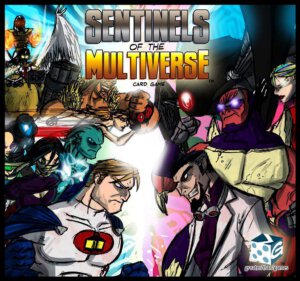
Publisher: Greater Than Games
Designers: Christopher Badell and Paul Bender
Year: 2011
Players: Two to five players
Ages: 8+
Playing Time: 60 Minutes
Genre: Cooperative superhero card game
Retail Price: $39.95
I think I’ll begin the review with the positives and then hunker down into reality as some major issues regarding the game and its gameplay begin to rear their ugly heads…
To begin I do like the art in Sentinels of the Multiverse; it’s fun and colorful and brings to mind the artwork you might find outside of the big two in the comic book world. Each character card is presented as the cover of a comic and the character’s hit points are displayed as an issue number. Each character comes across with a bit of personality as well and you might be drawn to giving each of the ten heroes a run for their money just to see what each brings to the table.
In the game you have three factors in play: Heroes, Villains, and Environments. All in all you’ll end up breaking down the over 550 cards included in the game into eighteen decks. You’ll have a deck for each character, good or evil, and the environments. There are four villains and four environments in which to do battle. This means there are a lot of possibilities and these factors give a great boost to replayablity.
The environments are a nice touch as well because they can be a boon or a bane to the villain or heros.
Each turn will play out in the same order. First, the villain begins by performing any effects that take place at the start of turn, then they draw a new card from their deck, and finally and end of turn effects take place. Each of the heroes will each take their turns by playing a card, using a power on their card, and then drawing a card from their own deck. Lastly, the environment takes a turn as well played out exactly as the villain’s turn.
That’s it! There you have it! So teaching the game is pretty quick and it won’t take anyone long to get the hang of the sequence of the goings on. I’d say ten minutes or more can get most first time players up to speed.
Looks like things are shaping up for this to be a winner, doesn’t it?
Sad to say the downsides of the game appear rather quickly and there are a multitude of them.
Sentinels of the Multiverse has way too much record keeping for a game of its nature. Every time you turn around you’ll find that you’re adding and subtracting a multitude of modifiers based on the villain’ effect, the villain’s card in play, your hero, you hero’s card in play, the environment, and the environment’s card in play. Sure, we’re not talking about long division here but I was surprised to see so many cases of adding this, subtracting that, adding this, subtracting that, etc. Plus you’ll always forget some modifier of some sort. This became more and more irritating after repeated play. Tracking the hit points of each hero and villain is a wee bit of a chore as well since the total is constantly changing – better bust out some D20s to lend a hand.
While the game is easy to learn that comes back to bite the design because the players never feel as if they have a whole lot to do. You’ll find almost every turn you get to take just breaks down into simply playing a card that will deal out the most damage. It takes a few plays before this starts to really set in but, by the time you might break the game out for a third or fourth time, you’ll find yourself scanning your game collection to see what might be more engaging than Sentinels of the Multiverse.
Two last issues need to be addressed…
There are situations that can arise, depending on the villain and environment being tackled, where you can have cards in play that reduce the players to nothing more than spectators. You can actually find the heroes in a spot where they can’t use a power, play cards, or draw any cards. Those are the only things you do in a turn so if you can’t do any of those things what’s the point of playing? This “screeching halt” isn’t something that’s going to happen very often but it does exist and needs to be mentioned. The fact that this happened within the first four play throughs was not a good thing.
Lastly, and this wasn’t a huge issue for me but I can guarantee that this would possibly induce Elliott to have a stroke, is the storage set up of the game. As in there isn’t one… You’re going to divide the cards into all these different decks but there’s absolutely no way to properly sort them due to the shallow depth of the box. So you’re left with either using rubber bands or baggies to sort the cards or just leaving them to intermix inside the box waiting to be divvied up again the next time you play.
If you’re someone who really would dig a co-op superhero experience you may want to give Sentinels of the Multiverse a try. For everyone else, myself included, taking a pass might be a better idea.
[rwp-review id=”0″]
- Chivalry & Sorcery Fifth Edition Reviewed - Nov 3, 2024
- Campaign Builder: Castles & Crowns Reviewed - Nov 2, 2024
- The Roleplaying Game of the Planet of the Apes Quickstart | First Look and Page-Through - Nov 1, 2024